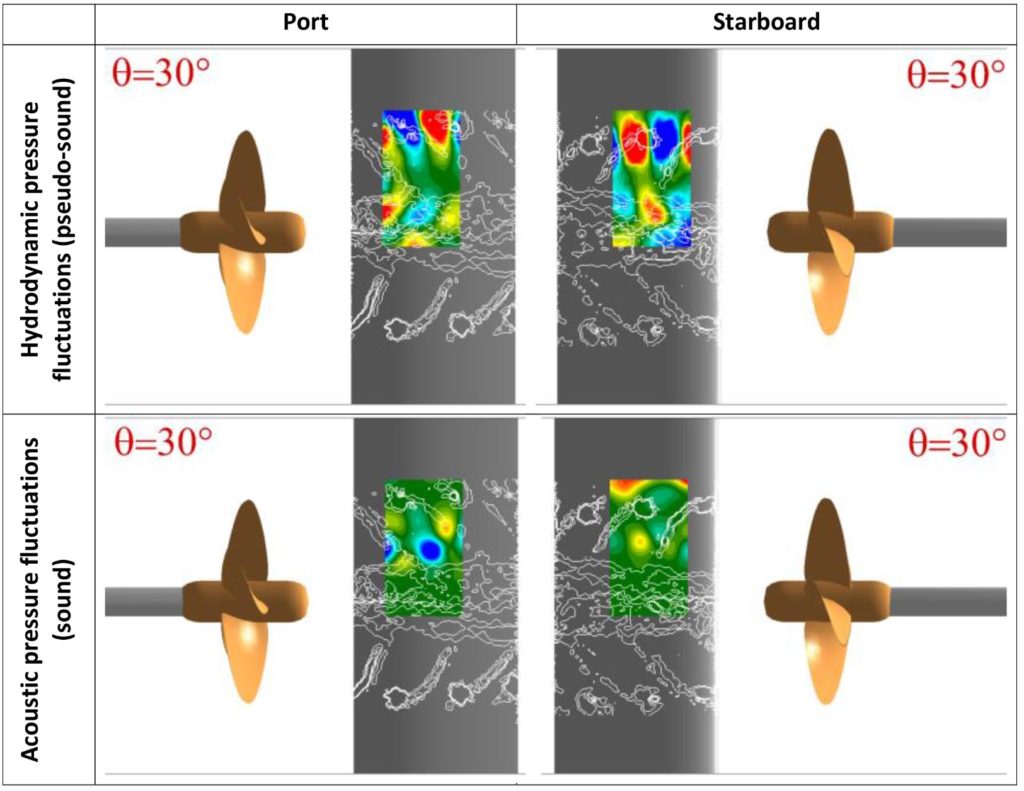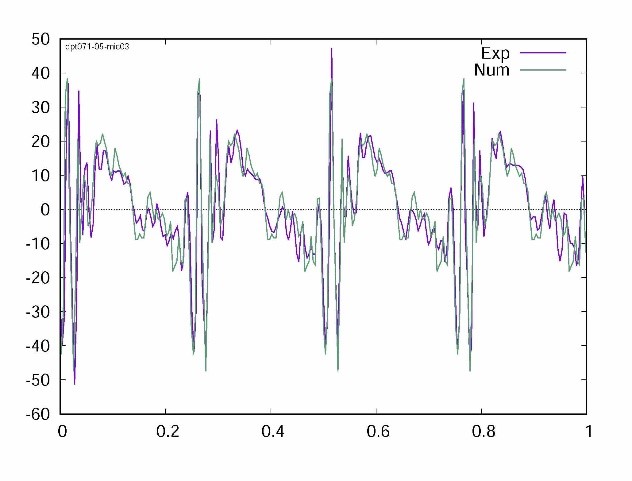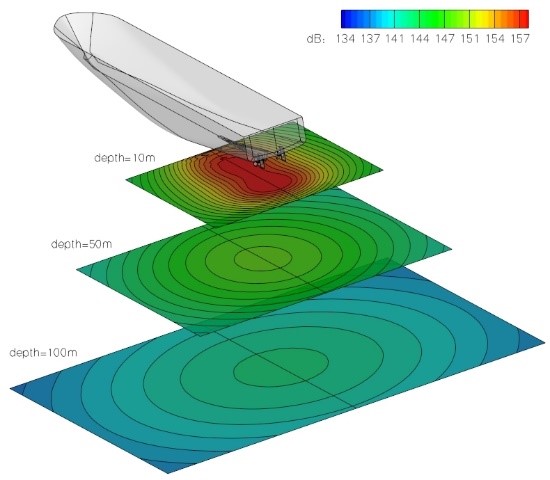Scope
| Underwater noise research is a topical issue of naval and marine engineering. In fact, the substantial growth of the shipping traffic (i.e. between 80% and 90% of international trade is transported by sea and this has increased more than four-fold since 1970) along with the general increase in the size and speed of commercial ships have produced a significant growth in the volume and intensity of underwater radiated noise (URN), that has been estimated by 3 to 6 db/year since the 60’s. This has made its negative effects on several aspects of marine life particularly harmful, especially on marine mammals. Therefore, the need to reduce the noise levels, particularly in regions where there is close proximity between ships, and marine life, has also become more important. One significant resulting initiative was the development of broad non-mandatory guidelines under the auspices of the International Maritime Organization (IMO), with the aim of reducing underwater radiated noise to levels that do not adversely affect the marine environment. To this end, research has been called to address the twofold task to develop effective noise prediction tools to support the diagnostics and the cost-effective evaluation of the design with regard to URN as well as to improve the understanding of the fundamental underlying mechanisms of the noise generation and radiation. These goals are pursuit at INM through a multidisciplinary research approach including, among the others, the development of prediction tools of the noise footprint and mapping, the metrology, the phenomenological research on hydrodynamics, cavitation and bubbly flows, the design of URN and internal noise mitigation and control solutions. |



Computational hydroacoustics: the noise maps, here computed for a complete ship at different depths, provide information on both the local noise level and the directivity of the hydroacoustic field.
Subtopics
| Prediction and diagnosis methods Experimental Hydroacoustics Experimental hydroacoustics is currently the most reliable approach to deal with URN problems and is crucial for the verification and validation of the computational methods. Besides the standard experimental methodologies for the prediction of the URN at full-scale by model testing, that are typically carried out in the large cavitation channel and, outdoor, in the natural basin Nemi’s lake, INM is active in the development and application of unconventional methodologies particularly suitable for the diagnostics and the investigation of hydroacoustic problems applied to naval and marine engineering. These consists of conditional sampling techniques based upon synchronous far-field pressure measurements using hydrophones and wake flow/acoustic pressure fluctuation measurements in proximity of the noise emitting body, using detailed flow measurement techniques, e.g. pointwise, planar and volumetric velocimetry techniques, such as Laser Doppler Velocimetry (LDV), Particle Image Velocimetry (PIV) and Tomographic PIV and time resolved visualizations along with advanced signal processing methodologies. The effectiveness of these unconventional methodologies has been proven by several successful applications in the civil and military fields. Computational hydroacoustics Computational hydroacoustics is a challenging research branch, devoted to the numerical prediction of underwater noise released by a ship and/or any of its subcomponents. At INM, this task is mainly achieved through the Acoustic Analogy and the use of integral formulations for the Ffowcs Williams-Hawkings (FWH) equation, which governs the noise generated by any body moving in a fluid flow. This equation directly arises from the fundamental conservation laws, expressed in terms of generalized functions; it enables not only an accurate evaluation of the acoustic disturbance at any point in the field, but also the identification of the main noise generating mechanisms related to the concerned source, thus suggesting possible strategies to alter and/or reduce their effects. The computational tools developed at INM are based on different solving techniques (direct approach, porous formulation, emission-surface algorithm, backward- and forward-in-time integration schemes, etc.) and also concern some no-conventional use of the FWH equation, as, for instance, in the analysis of scattering problems or noise prediction for a marine propeller in presence of sheet cavitation phenomena. |
| Metrology Reliable measurement of underwater sound is a key prerequisite for accurate validation of modeling and experiments, and to underpin monitoring of environmental status and noise impact assessment in the marine environment. INM has over 20 years of experience in underwater acoustic metrology, with its tank laboratory featuring calibration standards managed in agreement with ISO 17025 requirements, and its open water Nemi test site possessing unique characteristics for mid- and low-frequency acoustic measurements. INM is currently active in metrology research projects within the EU for the development of calibration methods for hydrophones and autonomous recorders, and participates in EURAMET TC-AUV technical committee on underwater acoustics, as well as in laboratory intercomparisons. Test and calibration services are offered for a variety of devices and configurations, in the frequency range from 200 Hz to the MHz range. |
| Basic research on cavitation phenomena and bubble dynamics The dynamics and the subsequent sound emission of a gas/vapor bubble in a liquid is investigated. This research activity is currently conducted along the following lines: i) development of mathematical models and computational tools for the simulation of the rectilinear motion of an axisymmetric bubble in a liquid; ii) comparative analysis of the dynamics and acoustic emission of spherical and axisymmetric bubbles; iii) development of a model for the dynamics of a bubble moving through an arbitrary flow; iv) extension of the axisymmetric model to simulation of the dynamics of a bubble near a wall or a free surface; v) investigation of a spherical or axisymmetric bubble in the presence of pressure disturbances. |
Selected projects
| AEROTRANET 2 – AEROnautical TRAining NETwork in Aerodynamic Noise from Widebody Civil Aircraft (Scientific director: Dr. Mario Felli) The Project AeroTraNet 2 (2012-2015) is a Marie Curie Action of the EU 7th Framework Programme (FP7). It trains Early Stage Researchers (ESRs) and Experienced Researchers (ERs) in front-line, integrated, industry relevant research in unsteady aerodynamics and noise for the next generation of environmentally friendly wide-body civil aircraft. Six academic partners address the common objective of modelling shock cell noise in a wide-body aircraft engine configuration from AIRBUS by shock-tolerant numerical modelling for under-expanded jets (University of Leicester), large eddy simulations for turbulent jets with weak shocks (Cerfacs), advanced flow-noise correlations (Università degli Studi Roma Tre), jet and near-field noise experiments (Von Karman Institute for Fluid Dynamics), reduced-order modelling and flow control (Institut de Méchanique des Fluides de Toulouse, IMFT-INP), and advanced laser-based measurement techniques (CNR-INM). Knowledge output is synthesized through a dedicated knowledge capturing programme by the University of Greenwich. |
| DECEIVING PROP – Analysis Methods and Design Measures for the Reduction of Noise and Vibration Induced by Marine Propellers (Scientific director: Dr. Mario Felli) The project DECEIVING PROP (2017-2019) was funded by the Italian Ministery of Defence within the National Plan of Military Research (PNRM). The project DECEIVING PROP proposes a research programme which deals with the study of the noise generation and radiation from marine propellers and aims at developing design solutions oriented to the control, mitigation and masking of the acoustic signature. In the first stage, the Project proposes a theoretical and experimental analysis of simple configurations. This stage is aimed at identifying the fundamental underlying mechanisms influencing the propeller noise generation, radiation and modulation. The results are then applied to a case study of military interest. The partnership involves CNR-INM (Principal Investigator), FINCANTIERI and CETENA. |
| ESMprop – Experimental Study of Hydrodynamics and Hydroacoustics of Marine Propellers (Scientific director: Dr. Mario Felli) The project ESMprop (2015-2018) was funded by the Office of Naval Research of the US Navy within the Naval International Cooperative Opportunities (NICOP) Program. The Project addresses the execution of a comprehensive experimental study on the hydrodynamics and hydroacoustics of a reference submarine vehicle andwas focused on understanding the fundamental mechanisms triggering the wake instability of a marine propeller and improving the comprehension of the fundamental underlying mechanisms of propeller noise generation and propagation phenomena. |
| PRONOVI – Analysis Methods and Design Measures for the Reduction of Noise and Vibration Induced by Marine Propellers (Scientific director: Dr. Mario Felli) The PRONOVI project (2018-2021) was funded by the MarTERA partners Research Council of Norway, German Federal Ministry of Economic Affairs and Energy and Italian Ministry of Education, Universities and Research and co-funded by the European Union. The objective of the ProNoVi project is to improve the numerical and experimental methods for the prediction of noise and vibrations induced by a propeller operating behind ship hull in full scale conditions, and to elaborate practical recommendations for the reduction of noise and vibration levels for single and twin-screw vessels of different size and speed range. |
| SATURN (Solutions At Underwater Radiated Noise) (Scientific director: Dr. Mario Felli) The Project SATURN (2021-2025) is funded by the European Community in the within the Horizon 2020 Framework Programme. The project brings together leading experts from a variety of disciplines (bioacoustics; population biology; marine mammal, fish, and invertebrate biology; maritime architecture and engineering; shipping; maritime policy; stakeholder engagement and science communication) to address the negative impacts of ocean noise on marine species and identify 1) The sounds that are most detrimental to aquatic species and how they are produced and propagated, 2) The short-term and cumulative long-term negative impacts of noise from shipping and boats on three representative groups of aquatic species in rivers and the sea (invertebrates, fish, and marine mammals) and 3) The most promising options for measuring and reducing the negative impacts of ship noise that can be applied to current and future vessels |
| SILENV – Ships oriented Innovative solutions to rEduce Noise & Vibrations (Scientific director: Dr. Sandro Ianniello) The SILENV project (2009-2012) was the first research programme financed by the European Community focused on acoustic themes in naval context. It arose from the need to solve or alleviate the many problems caused by noise and vibrations on maritime transport, with particular reference to noise pollution and its effects on marine fauna and port areas, to safeguarding the health of crews and to passengers’ comfort on board. Therefore, starting from a study and a collection of the current regulations on the subject, the research was addressed to different sectors, in order to propose and test innovative solutions and to define a “Green Label” identifying (on the basis of the characteristics of the current fleets) new regulatory targets for noise and vibration levels in new generation ships. |
| SONIC – Suppression Of underwater Noise Induced by Cavitation (Scientific director: Dr. Mario Felli) The SONIC project (2012-2015) was funded by the European Community in the within the 7th Framework Programme. The Project was aimed at developing computational and experimental tools to investigate and mitigate the effects of underwater noise generated by shipping, both in terms of the footprint of an individual ship (a “noise footprint”) and of the spatial distribution of sound from a large number of ships contribution to the sound (a “noise map”). The SONIC consortium consisted of world-leading hydrodynamic institutes, noise experts, propeller designers, reputable universities with specialised centres in this field, major European shipyards, and a class society; bringing together a wealth of knowledge on propeller cavitation and noise reduction. The SONIC project was executed in close co-operation with the EU FP7 AQUO project, by sharing data, organizing combined workshops and dissemination activities, and by joining forces on developing guidelines for industry and regulations. |
| SOUNDSCAPE – Soundscapes in the North Adriatic Sea and their impact on marine biological resources (Scientific director: Dr. Mario Felli) The Project SOUNDSCAPE (2018-2022) is funded through the European Union CBC Programme Interreg Italy-Croatia. The project includes the creation of a cross-border scientific and institutional cooperation is aimed at increasing the current knowledge on the underwater noise and the human activities that significantly contribute to it in order to ensure efficient protection of the sensitive marine species and the sustainable use of marine and coastal ecosystems. Current gaps in the knowledge on underwater noise are addressed by implementing continuous one-year monitoring of underwater noise in the sea by using the autonomous recording systems. In addition, the project involves the development/use of advanced sound propagation models to provide information on the spatial distribution of noise and variations in the noise levels in relation to human activities ongoing in the wider area of northern Adriatic Sea. |
| UNAC-LOW – Underwater Acoustic Calibration Standards for Frequencies Below 1 kHz” (Scientific director: Dr. Silvano Buogo) The project is funded within “The European Metrology Programme for Innovation and Research (EMPIR)” as part of the EU H2020 Framework Programme. The goal of the project is to develop the European Metrological Capacity in underwater acoustic calibration for acoustic frequencies below 1 kHz by providing traceable measurement capabilities to meet the need for calibration of hydrophones and autonomous underwater acoustic noise recording systems. The project aims at developing the scientific and technical research capabilities in the field within Europe, and provide an improved metrology framework to underpin the absolute measurement of sound in the ocean in support of regulation and EU Directives (such as the Marine Strategy Framework Directive) for which traceability is currently lacking. |
People
| Research Scientists and Engineers Silvano Buogo, , phone +39 06 50299 310 (Metrology) Elena Ciappi, , phone +39 06 50299 268 (Internal noise) Enrico De Bernardis, , phone +39 06 50299 328 (Cavitation phenomena and bubble dynamics) Mario Felli, , phone +39 06 50299 240 (Experimental Hydroacoustics) Sandro Ianniello, , phone +39 06 50299 249 (Computational Hydroacoustics) Giorgio Riccardi (University of Campania “Luigi Vanvitelli”), (Cavitation phenomena and bubble dynamics) Claudio Testa, , phone +39 06 50299 251 (Computational Hydroacoustics) |
| Research Fellows Fabrizio Metalli, phone +39 06 4548 8739 |
Selected publications
- S. Ianniello, The Ffowcs Williams-Hawkings equation for hydroacoustic analysis of rotating blades. Part 1. The rotpole, Journal of Fluid Mechanics, 797, 2016, pp. 345-388
- S. Ianniello, E. De Bernardis, Farassat’s formulations in marine propeller hydroacoustics, International Journal of Aeroacoustics, 14 (1-2), 2015, pp. 87-103
- S. Ianniello, R. Muscari, A. Di Mascio, Ship underwater noise assessment by the Acoustic Analogy. Part III: measurements versus numerical predictions, Journal of Marine Science & Technology, 19 (2), 2014, pp. 125-142
- S. Ianniello, R. Muscari, A. Di Mascio, Ship underwater noise assessment by the Acoustic Analogy. Part II: hydroacoustic analysis of a ship scaled model, Journal of Marine Science & Technology, 19 (1) , 2014, pp. 52-74
- S. Ianniello, R. Muscari, A. Di Mascio, Ship underwater noise assessment by the Acoustic Analogy. Part I: nonlinear analysis of a marine propeller in a uniform flow, Journal of Marine Science & Technology, 18 (4) , 2013, pp. 547-570
- S. Ianniello, New perspectives in the use of the Ffowcs Williams-Hawkings equation for aeroacoustic analysis of rotating blades, Journal of Fluid Mechanics, 570, 2007, pp. 79-127
- Riccardi G. and De Bernardis E. Dynamics of a spherical bubble rising in gravity, subject to traveling pressure disturbance. Comm. Appl. Ind. Math., 9(1), 149–158, 2018.
- Riccardi G. and De Bernardis E. Dynamics and acoustics of a spherical bubble rising under gravity in an inviscid liquid. J. Acoust. Soc. Am., 140(3), 1488–1497, 2016.
- Felli M., Falchi M., Dubbioso G., “Experimental approaches for the diagnostics of hydroacoustic problems in naval propulsion”. Ocean Engineering 106, 1-19, 2015.
- Felli M., Grizzi S., Falchi M., “A novel approach for the isolation of the sound and pseudo-sound contributions from near-field pressure fluctuation measurements: analysis of the hydroacoustic and hydrodynamic perturbation in a propeller-rudder system”. Experiments in fluids, 55-1, 1651, 2014.
- Felli M., Camussi R., Di Felice F., “Mechanisms of evolution of the propeller wake in the transition and far fields”. Journal of Fluid Mechanics, 682, 5-53, 2011
- Camussi R., Felli M., “Far field pressure fluctuations and coherent structures in a low mach number turbulent jet flow”. International Journal of Aeroacustics, Vol.3, n.4, October 2005.
- Biber, A.C. Çorakçı, A Golick, S. Robinson, G. Hayman, J. Ablitt, S. Barrera-Figueroa, S. Buogo, S. Mauro, F. Borsani, S. Curcuruto, M. Linné, P. Sigray, P. Davidsson, Calibration standards for hydrophones and autonomous underwater recorders for frequencies below 1 kHz: current activities of «UNAC-LOW» project, Acta IMEKO 7 (2018), N. 2, 32-38.
- K. Vokurka, S. Buogo, Experimental study of light emitted by spark-generated bubbles in water, Eur. Phys. J. Appl. Phys. 81, 11101 (2018).

